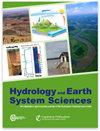Modelling groundwater recharge, actual evaporation, and transpiration in semi-arid sites of the Lake Chad basin: the role of soil and vegetation in groundwater recharge
IF 5.8
1区 地球科学
Q1 GEOSCIENCES, MULTIDISCIPLINARY
引用次数: 0
Abstract
Abstract. The Lake Chad basin, located in the centre of northern Africa, is characterized by strong climate seasonality with a pronounced short annual precipitation period and high potential evapotranspiration. Groundwater is an essential source for drinking-water supply, as well as for agriculture and groundwater-related ecosystems. Thus, assessment of groundwater recharge is very important although also difficult because of the strong effects of evaporation and transpiration, as well as the limited available data. A simple, generalized approach, which requires only limited field data, freely available remote sensing data, and well-established concepts and models, is tested for assessing groundwater recharge in the southern part of the basin. This work uses the FAO dual-Kc concept to estimate E and T coefficients at six locations that differ in soil texture, climate, and vegetation conditions. Measured values of soil water content and chloride concentrations along vertical soil profiles together with different scenarios for E and T partitioning and a Bayesian calibration approach are used to numerically simulate water flow and chloride transport using Hydrus-1D. Average groundwater recharge rates and the associated model uncertainty at the six locations are assessed for the 2003–2016 time period. Annual groundwater recharge varies between 6 and 93 mm and depends strongly on soil texture and related water retention and on vegetation. Interannual variability of groundwater recharge is generally greater than the uncertainty of the simulated groundwater recharge.乍得湖流域半干旱区地下水补给、实际蒸发和蒸腾模拟:土壤和植被在地下水补给中的作用
摘要乍得湖盆地位于北非中部,气候季节性强,年降水周期短,潜在蒸散量大。地下水是饮用水供应以及农业和与地下水有关的生态系统的重要来源。因此,评估地下水补给是非常重要的,尽管由于蒸发和蒸腾的强烈影响以及现有数据有限也很困难。试验了一种简单、广义的方法来评估盆地南部的地下水补给,该方法只需要有限的实地数据、可免费获得的遥感数据和完善的概念和模型。本研究使用粮农组织的双kc概念估算了土壤质地、气候和植被条件不同的六个地点的E和T系数。利用Hydrus-1D软件对垂直土壤剖面上土壤含水量和氯离子浓度的实测值、不同的E和T划分方案以及贝叶斯校准方法进行了数值模拟。评估了2003-2016年期间六个地点的平均地下水补给率和相关的模式不确定性。地下水年补给量在6至93毫米之间变化,在很大程度上取决于土壤质地和相关的保水能力以及植被。地下水补给的年际变化一般大于模拟地下水补给的不确定性。
本文章由计算机程序翻译,如有差异,请以英文原文为准。
求助全文
约1分钟内获得全文
求助全文
来源期刊

Hydrology and Earth System Sciences
地学-地球科学综合
CiteScore
10.10
自引率
7.90%
发文量
273
审稿时长
15 months
期刊介绍:
Hydrology and Earth System Sciences (HESS) is a not-for-profit international two-stage open-access journal for the publication of original research in hydrology. HESS encourages and supports fundamental and applied research that advances the understanding of hydrological systems, their role in providing water for ecosystems and society, and the role of the water cycle in the functioning of the Earth system. A multi-disciplinary approach is encouraged that broadens the hydrological perspective and the advancement of hydrological science through integration with other cognate sciences and cross-fertilization across disciplinary boundaries.
 求助内容:
求助内容: 应助结果提醒方式:
应助结果提醒方式:


